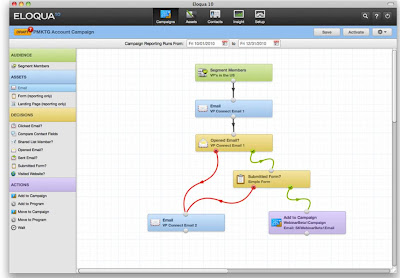eTrigue officially announced its new DemandCenter marketing automation system on Tuesday, replacing an earlier product dating back more than five years.
The system is positioned as “marketing automation for the rest of us”, meaning that eTrigue considers it much easier to use than leading marketing automation products. If that sounds familiar, it’s because I recently mentioned similar claims from Net-Results , Act-On Software, and tMarketbright. All believe that the complexity of standard marketing systems is the major reason they have not been more widely adopted and that they can offer a simpler alternative.
Bear in mind that’s a two-part proposition. Even if these vendors are right that complexity is the key barrier to adoption, there’s no business opportunity unless their systems are simpler. Otherwise, they’ve simply explained why marketing automation can never succeed, or at least won’t succeed until a critical mass of marketers have been trained to handle a new level of complexity.
So let’s cut to the critical question: is DemandCenter easier to use than systems like Pardot, Marketo, and Genius? The answer is a definite…maybe. DemandCenter has a campaign flow interface that does seem easier to use than standard products. But the rest of it, while nicely done, doesn’t strike me as materially different.
What makes the campaign builder different? Well, most systems use some variation of two basic approaches. One is to create a classic branching flow diagram, like a Visio chart. Here’s a state-of-the-art version from Eloqua:

This has the advantage of displaying the exact flow of leads, including branches that split apart and come together. It allows complex flows and is pretty much the way that most people diagram a campaign when they're planning it. But flow diagrams get confusing once you move beyond a handful of branches.
The other option is to build a list of steps without any branching. Rules within each step can still deliver different treatments to different segments, but everyone moves to the same next step at the same time. This is easier to follow but it lacks flexibility and you must look inside each step to see the details. Here is Marketo’s version:

DemandCenter lies somewhere in between. It lays out the steps within a single sequence on a row – similar to the list of steps but sideways. But it also allows distinct branches, showing each branch as its own row. This isn't perfect – you can’t draw lines to connect different boxes across branches, as in a flow diagram – but it’s probably more intuitive than the other approaches for moderately complex flows. Users can also collapse an entire, multi-branch campaign onto a single row and show multiple campaigns on the screen.

(Of course, nothing is truly unique. DemandCenter’s approach is conceptually similar to the interface introduced by Silverpop last year, which also showed branches as horizontal tracks. I liked that one too.)

So let's grant that eTrigue has built a somewhat better mousetrap. How much does it really matter? The campaign interface is just one of many components within a marketing automation system. A better campaign interface by itself is not enough to radically change the complexity of marketing automation as a whole.
Now, if all DemandCenter features were easier than the competition, that might change things. But while the rest of DemandCenter is well designed, nothing struck me as different enough to make a substantial difference in usability. So if superior ease of use is the only way for eTrigue to distinguish itself, it will have a very hard time.
But marketing automation systems actually compete on more than ease of use. eTrigue’s original product was originally developed in 2004/2005 by Silicon Valley marketing agency 3marketeers, which couldn’t find a system that met its own needs. The system has since been sold to about 150 clients. This long experience has led eTrigue to include capabilities that are missing in most low-to-mid-tier marketing automation products. These include:
- anonymous visitor look-up, based on IP address, with automatic exclusion of ISP addresses
- reporting on anonymous visitors as individuals (not companies) and indefinite retention of anonymous visitor histories (most systems erase the related cookies after a few months)
- real-time sales alerts triggered by lead behaviors
- ability to send leads directly from one campaign to another
- statistics for each campaign step visible in the campaign flow diagram
- a cube-based data mart for time-series analysis and other advanced reporting
- automated execution of reports on user-defined schedules
- precise user- and group-level security, including options to limit specific campaigns to specific users
- ability for Salesforce.com users to send emails through eTrigue
- tailored dashboards for each user
These are in addition to the usual marketing automation functions: email campaigns, landing pages and forms, lead scoring, and bi-directional integration with both Salesforce.com and Microsoft Dynamics.
That's a richer feature set than most marketing automation systems targeted towards the small and mid-size business. But pricing of DemandCenter is actually lower than most vendors in that segment, starting at $1,000 per month for a 10,000 name database. This includes implementation and training. The combination of mature features, a new interface, and low pricing makes eTrigue an attractive alternative even if it doesn’t break any major barriers for ease of use.
eTrigue also has a product aimed at salespeople, called SalesPro. This works directly from a Salesforce.com database, using the Salesforce.com email engine but applying eTrigue email authoring, campaign structures, Web tracking, and lead scores. The system doesn't include landing pages. It's priced at $500 per month for 10 users.


No comments:
Post a Comment